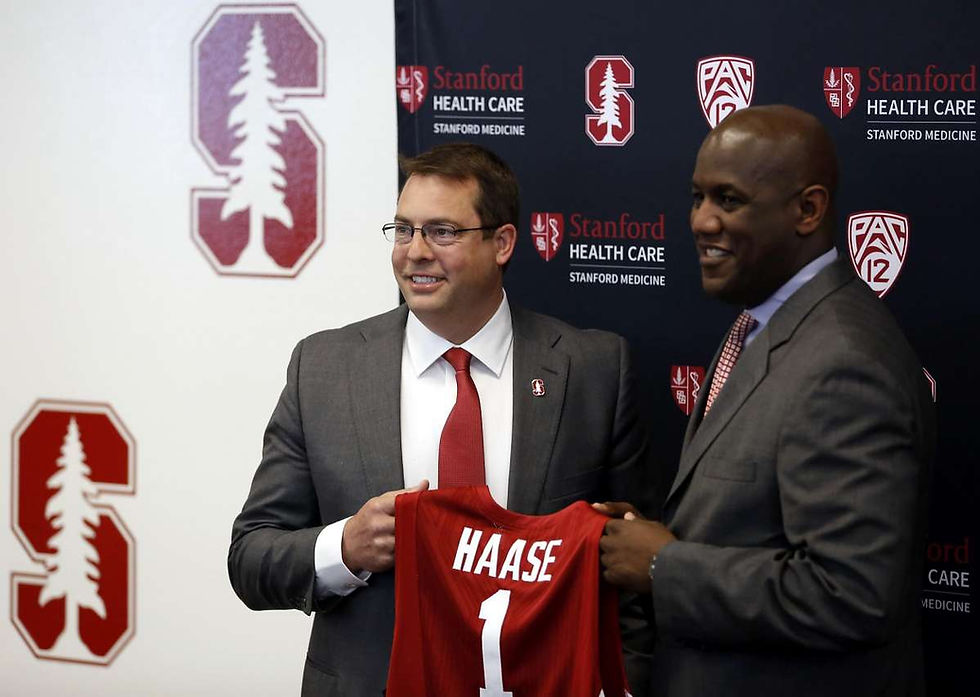Playoff Paralysis; Time for a Change at Stanford
- Gary Cavalli
- Feb 21, 2022
- 4 min read
Last June, to great fanfare, the College Football Playoff committee announced that after two years of study its "working group" had developed a proposal for expanding the CFP from four teams to 12 teams.
Universal excitement and anticipation ensued, not just among players and coaches who suddenly believed a playoff opportunity was possible for their school, but for millions of fans throughout the country tired of seeing the same teams every year.
The expectation was that the new format would be implemented for the 2024 season, two years prior to the expiration of the current 12-year agreement, because everyone was anxious to move forward and get some new blood into the playoff.
Well, not so fast.
On Friday the CFP announced that the commissioners of the 10 conferences and the Notre Dame athletic director were unable to reach agreement to approve the 12-team format, and that a four-team field would remain in place for four more seasons. The next day, presidents and chancellors from the leagues and Notre Dame voted 8-3 to approve, failing to achieve the unanimous vote needed to make the change.
The natural question to be asked is, what happened? Why did something that everyone wanted get sidetracked?
The simple answer? Petty jealousies and self-interest among the commissioners. You know, the guys who are paid millions to do what's in the best interest of college football.
This was an appalling, embarrassing display of failed leadership.
Among the issues: the proposal called for the field to include the six highest-ranked conference champions, along with the next six highest ranked teams, but the Big Ten insisted that all Power Five champs receive an automatic bid. The ironic thing is that this is really a non issue. Six spots ensures one Group of Five participant, and the chance of two Group of Five champs ranking above one of the Power 5 champs is minimal, at best.
The ACC, for some reason, was still championing an eight-team event, favored by no one else in the room, while the Pac-12 stubbornly insisted that the Rose Bowl be guaranteed its Jan. 1 afternoon time slot, essentially ruling out playoffs on that day.
Another issue was distrust emanating from the SEC’s poaching of Texas and Oklahoma from the Big 12.
When the final vote was taken, the members of the “Alliance”—Pac-12, Big Ten, and ACC—voted no and sabotaged the new playoff proposal, something that would benefit them more than anyone else. Crazy…
And so, dear fans, the "Four More Years" chant heard often in political circles now resonates in the world of college football. Four more years of the same teams, the same lack of opportunity for so many teams deserving of a chance to compete for the national title, and the same endless blather about Nick Saban, Kirby Smart, Dabo Swinney, and The Ohio State University.
God help us.

Cardinal Blues: Stanford’s men’s basketball team went into last week’s Pac-12 games on the NCAA bubble, with a 15-10 record, 8-7 in league, and a very favorable schedule. With Utah, Colorado, Cal, Arizona and Arizona State remaining, the Cardinal figured to win four out of five, finish 19-11 and 12-8, and have a good shot at getting into the tournament for the first time since 2014 with a decent performance at the Pac-12 championships.
But as has been the case so often over the last six years, the Cardinal choked.
On Thursday night, leading lowly Utah 54-48 with four minutes remaining, Stanford coach Jerod Haase inexplicably went to a lineup with no guards. Everyone on the floor was at least 6-7. All forwards and centers. No Michael O'Connell. No Isa Silva. Nobody to handle the ball except 6-7 freshman “point forward” Harrison Ingram.
The game turned on three straight Stanford turnovers. By the time Haase put Silva back in the game with less than two minutes to go, Utah was ahead. So Stanford lost at home to a team that went into the game with a 2-13 record in league play.
This inexcusable coaching blunder, in all likelihood, doomed the Cardinal's chances of getting into the NCAA tourney.
But Haase’s troops weren’t through. They sealed the deal two nights later when, after leading by two at halftime, they collapsed in the second half and lost by 17 to Colorado.
We recommended making a coaching change after last season, Haase's fifth straight without getting into March Madness. But Athletic Director Bernard Muir, perhaps inhibited by his own issues—the embarrassing involvement in the Varsity Blues scandal and the fallout from unsuccessfully trying to cut 11 sports—did not pull the trigger.
Haase is a good recruiter. His recruiting classes have ranked in the top 20 nationally three out of the past four years.
But despite top 20 talent, he’s been unable to crack the 68-team NCAA Tournament field six straight years.
The cold, hard fact is that Haase doesn’t know how to win. His teams play solid defense and rebound well, but they are stagnant and impotent offensively. They turn over the ball again and again and again. They can’t hit free throws down the stretch. Time after time, they fold in the second half, at crucial junctures and at the end of games.
The players—and the fans—deserve better. These kids come to Stanford for a great education, to develop as players, and to contend for championships.
Well, one out of three isn’t enough. It’s time for a change.


Comments